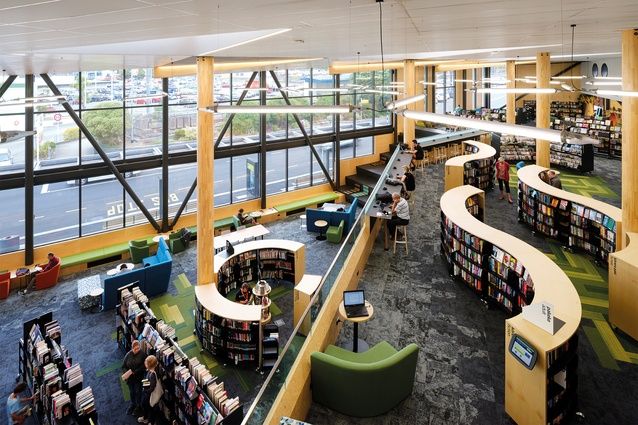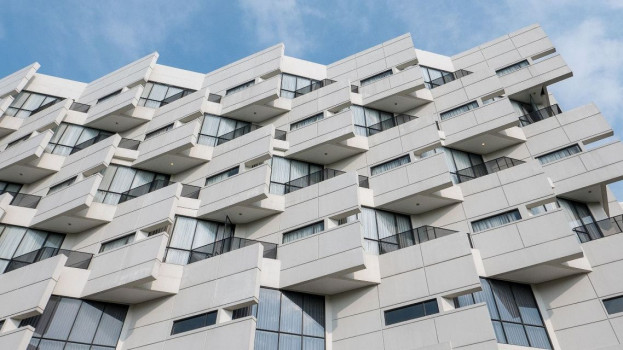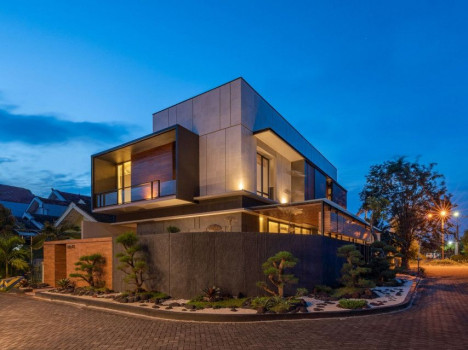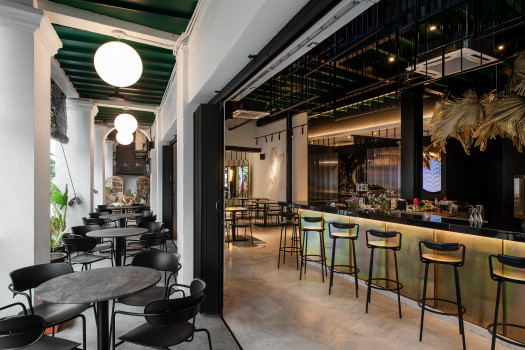Going beyond the brief



An assertive new library has emerged in Johnsonville’s town centre on Wellington’s road north from the western suburbs of Karori, Wadestown and Khandallah. Immediately noticeable for its angularity and tallness on the street edge, its openness and the welcome it signals, it is an unexpected architectural moment, highlighted by its contrast to the otherwise mundane built context.
Johnsonville was named after the first colonial settlers of the area. Beginning as a clearing in the bush on the original Māori path north to Porirua, over time it became an important stop on the journey from Wellington, the terminus of a train line north in 1886, then a farming hub, and a rural service centre, before suburbanisation from the 1930s. It is also a crossroads between the two major northern paths and, for most people, it remains an uneventful place they pass through. It is well connected to the city centre by both train and motorway, yet, it is a place apart, separated geographically from Wellington harbour by the Ngauranga Gorge and Newlands Hill.
Johnsonville is recognised for its poor-quality urban design – car-focussed, with an improvised character centred on a run-down mall opened in 1969. Its strategic location makes it an important part of Wellington’s planned urban intensification along the northern growth corridor but little has signaled this change, except some medium-density housing that follows a slightly mean commercial formula.
In its 175-year history, there has been little architecture in the Johnsonville suburban centre. Its modest architectural legacy includes the now-redundant 1964 low-scale, single-storey library in Broderick Road and the 1995 curvy, wiggly and labyrinthine Johnsonville Community Centre (both designed by the Wellington City Council Architectural Office), plus the Keith Spry indoor pool complex, upgraded by Architecture HDT in 2013. These buildings are on the edge of the commercial area, the latter two on the other side of the major arterial Moorefield Road, opposite ‘the triangle’ centre commercial area created by the crossing of the two original paths the area grew around.
This was the context for the 2015 WCC Waitohi Johnsonville Library and Community Hub project, a Wellington City Council invited design competition. The site offered was a tiny leftover triangular carpark next to the pre-existing community centre and pool. The commission was won by Athfield Architects based on a design that prioritised connections to the urban context and placemaking: the architects advocating a visionary wider urban redevelopment to restructure and reconnect the existing urban fabric of Johnsonville. The firm’s competition response asked the question: “Is this really what you want?” and showed the implications and possible alternatives.
Athfields has a legacy of prioritising a social urbanistic understanding in its architecture, resulting in projects that transform their immediate contexts well beyond the project boundaries. This occurred in Palmerston North in 1996, when the new Athfield-designed library literally transformed the sleepy suburban city, regenerating High Street as an urbane precinct and reconnecting it to the square through a new library concourse.
Wellington has also benefited from projects such as the currently-under-threat City Library, the Adam Art Gallery and Hub projects at VUW, and the CoCa building at Massey. In a similar manner, the Waitohi Johnsonville Library and Community Hub does a huge amount of urban work, bridging topography, creating new pathways, connecting and editing adjacent buildings and their associated landscapes.
The open and well-communicated design approach was critical – grounded in extensive consultation, workshops and communication with local iwi and community stakeholders. The community voted to determine the site and the project proceeded with a community reference group and in close communication with a librarian and project management team.
The engagement process resulted in the brief changing in several fundamental ways. The extent of proposed community meeting spaces within the library were cut back to collaborate with adjacent existing facilities. A poorly-utilised youth meeting space within the Johnsonville Community Centre was the exception, and was demolished and replaced within the brief with a youth-focused, multipurpose, digital maker space.
The neighbouring site behind was purchased from a local early childhood education centre and was also integrated within the new project. This move allowed some breathing space, meaningful connections to be created to the existing park and landscape beyond, plus a new carpark and landscaped courtyard to be formed. A new, publicly-accessible western face for the building, a second main entrance and the concourse path through the site were then possible.
The western courtyard opens up onto a café, the most popular facility requested through the community process. Most of the parking in the brief was removed – a move which recognised the carpark-saturated environment of the existing suburban centre and the urban transformation that was beginning. Gaining community buy-in to remove most of the proposed new parking was a validation of the engagement process in this suburban, car-reliant community.
The major urban design move was the new western landscaped courtyard and the associated concourse stepping down through the building and linking Memorial Park, the indoor pool complex, the integrated Whānau Manaaki Kindergarten, the café and library. The courtyard creates a strong western face for the building too, with a series of vertical screens feathering its edge, and sheltered canopies and on accessible walkway to the street.
The two major entrances to the building forge potential connections through to the adjacent Johnsonville Community Centre and across the road to the mall and transport hub.
The library’s recessed main entranceway is clearly expressed, incorporating an elegant series of tall fins by Matthew McIntyre-Wilson to reflect the area’s Māori heritage. It opens into a generous concourse space and stairway leading up and through to the courtyard and park beyond. When I visited it on a weekday morning, the library was buzzing with activity. People in the lower level were engrossed in their own literary worlds, settled and reading in the sunshine on window seats and working around tables throughout the library landscape in a variety of locations and ways.
The lofty, truncated, triangle-shaped main library space is terminated by a stair with terraced platform facing back into the area and transitioning to the upper mezzanine terrace level with teen, children’s and fiction zones. A mothers’ group was meeting and children were excitedly exploring and engaging in the children’s library discovery area, nestled under an upper floor level. I met the architects in the café which, in pre-COVID-19 days, was delightfully full. The café interconnected to the upper level of the library and the western courtyard, yet there was no library security system evident. To date, it hasn’t been required.
The Whānau Manaaki Kindergarten is above the children’s library zone, ablutions, staff workroom and café areas. It was also a hive of activity, with children engaged in a wonderful screened, sheltered and partially covered outside courtyard and peering down through circular windows to the spaces below. A staffroom shared by all building users completes the upstairs area. The upper part of the concourse links to the Keith Spry Pool, creating an improbable and unexpected connection between water and books, yet, it works – the café acting as interface between the two. The occasional damp child with a towel is a welcome trade-off for the opportunities for community connections created through the adjacent uses.
There is also a reading of the library as a landscape integrated into its context, mending and interconnecting the edges of the site and adjacent urban fabric. This occurs through a series of exterior and interior terracing and steps, opened both to the upper park and western courtyard and cascading down to the street level on the east, where the library also opens up wonderfully along the street edge to the carparks and town centre beyond. It’s not easy to do this in library projects, with their necessarily closed edges and book security. The large canopy and bus stops give the glazed library frontage a double-sided aspect and visually activates the secure edge.
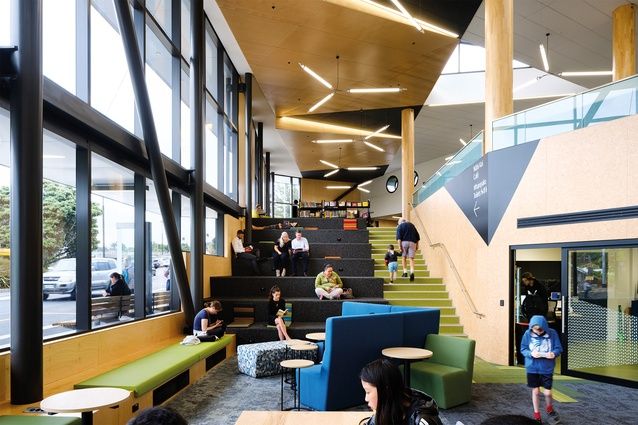
The landscape reading continues through the interior. The architects have used the origin of Johnsonville as a clearing in the bush as a metaphor for the building: hence, a forest floor and a series of massive timber tree trunk columns reaching up to a roof canopy punctured with roof lights introducing overhead light. Like the enormous tree trunk columns in Otaki’s Rangiātea Church, these columns have an elemental presence, enlivened by the texture of crafted, hand-finished timber work with its slight imperfections.
The abstracted roof canopy also romances the triangle motif derived from site and Johnsonville’s wider urban form. This is repeated within the structure and substructure of the building, at times almost fractal-like in its insistence. Exposed, tubular-steel structural frames triangulate a trussed bracing system throughout the building. Within the concourse, this creates an unfortunate clash of a freestanding triangular brace with a top-lit exhibition wall that it frames. There is a robustness evident in the finishes, with the necessity of thick, steel base plates and bolted connections exposed as virtue, and there is a layering of finishes with substructure also exposed at times, tidy, but not too fussy.
The Waitohi Johnsonville Library and Community Hub is an urban confluence. It is city-making at its best, sensitive to and reordering a surrounding suburban town centre that had a real need of it. It weaves the urban complexity and synthesises it with a community-focussed clarity, creating a social heart that people are already very at home in. It does a lot with a little, its edges reforming the urban spaces they help create and connect to and anticipating potential future changes over time. It’s been a long wait, but Johnsonville town centre finally has an architectural presence with civic gravitas and scale.




 Australia
Australia
 New Zealand
New Zealand
 Philippines
Philippines
 Hongkong
Hongkong
 Singapore
Singapore
 Malaysia
Malaysia


